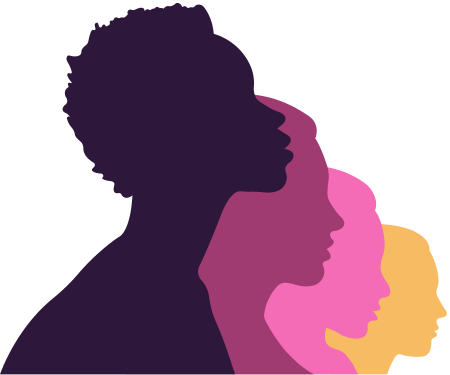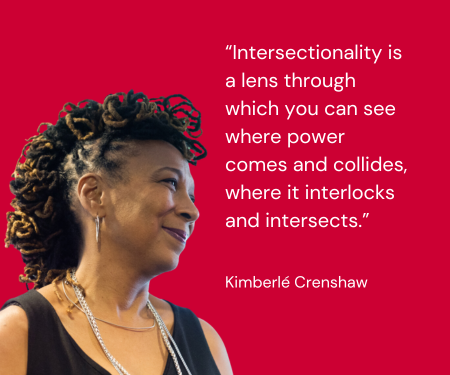How to Teach an Intersectional Women’s History Month

We all have identities that affect how we interact with the world. A classroom is no different, with every student using their unique backgrounds and experiences to connect with the material. By understanding intersectionality and how individuals experience the world through their identities, teachers are better tuned into how to reach their students.
During Women’s History Month, it is important to incorporate intersectionality’s principles into lessons so students see themselves in history makers. For female students, feeling seen during Women’s History Month can improve academic performance.
Studies back up the importance of gender-responsive pedagogy, which considers student gender identity and gender norms. For example, a UNICEF study in Ethiopia, Malawi and Tanzania found the strategy increased retention and academic performance for female students. Another study found an increase in STEM subjects when students were taught with a gender-responsive lens.
By focusing on gender-responsive pedagogy and understanding their students’ intersecting identities, educators can decrease stereotyping and increase classroom participation.
What is intersectionality?

Intersectionality considers how intersecting identities affect how people are viewed and treated in the world. For example, a Black and queer man experiences the intersection of race and sexual identity, while a Black queer woman experiences the intersection of race, sexual identity and gender.
Credit goes to Kimberlé Crenshaw for coining the term ‘intersectionality’ in 1989. Crenshaw, who is a scholar, writer and professor of law, is known for her three decades of civil rights work. In addition to introducing intersectionality as a concept, Crenshaw is also one of the legal scholars who established critical race theory and has identified how the school-to-prison pipeline also affects Black girls.
Intersectionality was born out of Crenshaw’s work developing critical race theory. She first introduced the concept in a paper published in the University of Chicago Legal Forum, “Demarginalizing the Intersection of Race and Sex.” In the paper, Crenshaw focused on three legal cases that included both racial and sex discrimination and argued the court has “single-issue analyses,” which is detrimental to Black women, who experience both race and sex discrimination in courtrooms.
“Intersectionality was a prism to bring to light dynamics within discrimination law that weren’t being appreciated by the courts,” Crenshaw wrote in her paper. “In particular, courts seem to think that race discrimination was what happened to all black people across gender and sex discrimination was what happened to all women, and if that is your framework, of course, what happens to black women and other women of color is going to be difficult to see.”
Like critical race theory, intersectionality was created to reduce bias in law. The concepts, however, have spread and proven beneficial in many areas and the term itself broke into mainstream feminism in 2017, thanks to a boost from the Women’s March on Washington.
Teaching history from all angles
The suffrage movement is a great example of women’s history that often glosses over the challenges and contributions of Black women, who faced bigger risks due to combined racism and sexism. The movement, historically credited to Elizabeth Cady Stanton and Susan B. Anthony, was initially a segregated effort. The National American Woman Suffrage Association did not allow Black women to attend its conventions. As a response, the National Association of Colored Women’s Clubs was formed by Harriet Tubman, Frances E.W. Harper, Ida B. Wells and Mary Church Terrell.
The Fifteenth Amendment is a great example of how intersecting identities affect a person’s decisions. Even though the Fifteenth Amendment did not grant women the right to vote, many Black women still offered support, as the amendment eliminated race discrimination in voting. Meanwhile, white suffragists staunchly opposed the Fifteenth Amendment, wanting to gain voting rights before Black men.
When women gained the right to vote when the 19th Amendment was ratified in 1920, Black women still had to go through hurdles. Poll taxes, literacy tests, grandfather clauses and lynching threats kept many Black Americans from the polls. To have their vote count, Black women organized, teaching one another how to get over those hurdles.
When celebrating the 19th Amendment in Women’s History Month lessons, it is just as important to educate students on the challenges minority women faced to earn the same right.
How do you practice intersectionality?

Viewing the world through an intersectional lens is something you get better at with practice. Here are some ways you can practice intersectionality in your life so it shows up in the classroom.
Consider the way someone’s background affects them
Nothing is a universal experience when you consider each person’s unique background. We engage with and experience the world differently based on race, gender, sexuality, socioeconomic status, location and more.
Recognize intersectionality isn’t limited to gender
In the years since Crenshaw crafted the term, ‘intersectionality’ has become a useful tool in understanding how one person can experience bias and marginalization in multiple ways. LGBTQ+ individuals of color, for example, have a way to explain how the bias they experience is different from others within their community.
Give equity to BIPOC and LGBTQ stories and voices
When highlighting historical figures during lesson planning, be mindful if you are giving preference to white, straight, cisgender historymakers. Marginalized identities are often drivers of history, so look into individuals who had a hand in human rights movements. Educators now have more resources than ever, so finding stories like STEM contributions from Black women is only an online search away.
Intersectional Women’s History Month resources
As Women’s History Month approaches, now is the perfect time to create a more intersectional learning experience for students. The below resources have a mix of personal and professional development, as well as lesson plans and media that help students grasp intersectionality and introduce them to diverse historical figures.
Antiracism and Intersectionality Resources
This long resources list includes links to anti-racist articles, videos and podcasts to incorporate in the classroom, as well as syllabi, lesson plans and a glossary of anti-racist terms to help guide educators. The resources primarily lean toward high school and college levels, however, there are a few elementary and middle school options listed.
Celebrating and Empowering Black Women
This article highlights various ways to incorporate the stories and works of Black women into the classroom, as well as creative prompts and questions for discussion and reflection for students to engage with.
Honoring Women’s History Month and Intersectionality
This article from Morningside Center serves as a framework for introducing students to intersectionality and includes a list of inspirational Black women who are currently making history.
This podcast is hosted by Crenshaw and features guests like Dr. Cornel West, Bob the Drag Queen and George Johnson, who is one of the most banned Black authors in America.
Intersectionality Resource Guide and Toolkit
This toolkit is a great professional development resource for educators who want to understand intersectionality and its concepts better. It includes helpful tables and graphs to help break down ideas, as well as a framework for action.
Kimberlé Crenshaw: What is Intersectionality?
This video features Crenshaw explaining intersectionality in her own words.
The ‘intersectionality’ search via Teachers Pay Teachers is filled with classroom resources made by teachers. A bonus is any purchase off of the platform goes into a teacher’s pocket.
Teaching About Intersectionality
Educators 4SC compiled a list of lesson plans, articles and informational sites teachers can use as they plan their Women’s History Month lessons.
Learning for Justice is always a great resource for intersectional and anti-racist teaching materials. This specific feature takes a closer look at how to properly honor and teach about students’ multiple identities.
The Urgency of Intersectionality
Another resource featuring Crenshaw’s work, this TEDTalk shows how race and gender bias can combine to create more harm.
Why Equity Matters in Education
This YouTube video succinctly summarizes the concept of equity within a minute.
If you’re considering following your dream of teaching, Rutgers Alternate Route can offer you the support and training you need to succeed. Be sure to follow Rutgers Alternate Route on Twitter and sign up for Alternate Route’s monthly newsletter for more information and stories from the field of education.

 Lindsay Patton is a digital communications professional who specializes in social media, writing, digital marketing, e-commerce, podcasting and other content-focused endeavors. Since 2019, she has assisted Alternate Route with its marketing strategy to help the program reach new audiences. As a result of this collaboration, Alternate Route has introduced Lindsay to many of New Jersey's talented educators, who have had a direct influence on her own classroom strategies as an adjunct professor. She is grateful for the opportunity to create meaningful content that helps increase equity within classrooms and is inspired by Alternate Route's hardworking team.
Lindsay Patton is a digital communications professional who specializes in social media, writing, digital marketing, e-commerce, podcasting and other content-focused endeavors. Since 2019, she has assisted Alternate Route with its marketing strategy to help the program reach new audiences. As a result of this collaboration, Alternate Route has introduced Lindsay to many of New Jersey's talented educators, who have had a direct influence on her own classroom strategies as an adjunct professor. She is grateful for the opportunity to create meaningful content that helps increase equity within classrooms and is inspired by Alternate Route's hardworking team. 





